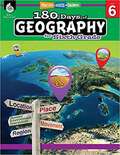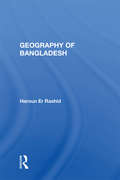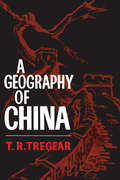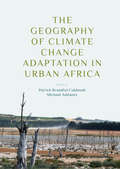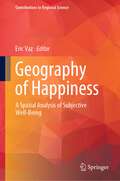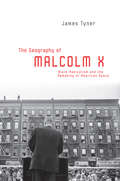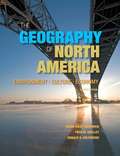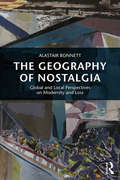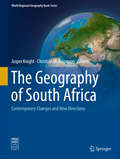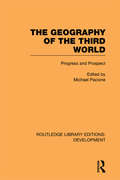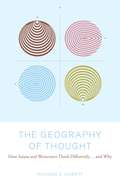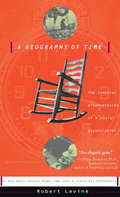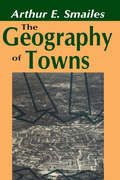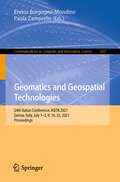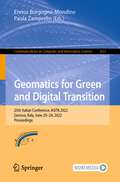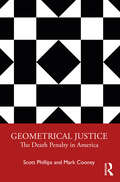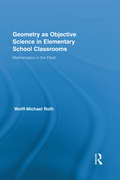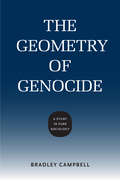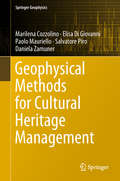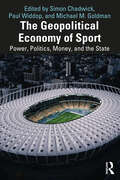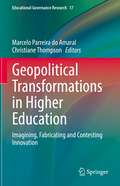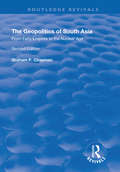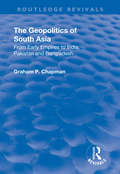- Table View
- List View
Geography, Level 6: Practice, Assess, Diagnose
by Jennifer EdgertonSupplement your social studies curriculum with 180 days of daily geography practice! This essential classroom resource provides teachers with weekly geography units that build students' geography knowledge, and are easy to incorporate into the classroom. <p><p> In a world that is becoming more connected and globalized, 21st century students must have the skills necessary to understand their world and how geography affects them and others. Students will develop their map and spatial skills, learn how to answer text- and photo-dependent questions, and study the 5 themes of geography. Each week covers a particular topic and introduces students to a new place or type of map. <p><p> The first two weeks consist of a mini-unit that focuses entirely on map skills. For additional units, students will study various places, and how culture and geography are related. With a focus on the six populated continents, students will explore various types of maps including physical maps, political maps, topographic maps, thematic maps, climate maps, regional maps, and various topics including scale, legends, cardinal directions, latitude and longitude, and more. Aligned to state standards and National Geography Standards, this resource includes digital materials.
Geography Of Bangladesh
by Haroun Er RashidIn its struggle for independence, Bangladesh became the focal point of world attention in the early 1970s. It emerged victorious, but its development was hindered by the after-effects of the war—the destruction of much of its infrastructure, problems of governmental change, and the enormous difficulties faced by government and aid officials in assembling a data base for long-range planning. Professor Rashid's book—the first major comprehensive geographic inventory of Bangladesh—provides the key elements for such a base. Emphasizing the rural and agricultural characteristics of the country, it also covers in depth its physiography, hydrography, climate, soils, land utilization, migration and settlement patterns, transportation infrastructure, and human and natural resources.
A Geography of China
by T.R. TregearThis book is intended primarily for serious students of geography but it will also appeal to the general reader. For this reason technical terms have been used as sparingly as is consistent with correct meaning. Wherever the subject matter permits, the author emphasizes geographical growth and shows the interaction of geographical environment and the human activity and institutions. When originally published in the 1960s China was beginning to change with breathtaking rapidity. These changes are presented here against geographical and historical background. Knowledge of the environmental facts is essential to an appreciation of the political, economic, and social problems that have faced the Chinese people.
The Geography of Climate Change Adaptation in Urban Africa
by Patrick Brandful Cobbinah Michael AddaneyThis book take a comprehensive look at several cases of climate change adaptation responses across various sectors and geographical areas in urban Africa and places them within a solid theoretical context. Each chapter is a state-of-the-art overview of a significant topic on climate change adaptation in urban Africa and is written by a leading expert in the field. In addition to the focus on the geography of urban adaptation to climate change in Africa, this collection offers a broader perspective by blending the use of case studies and theory based research. It examines transformations in climate change adaptation and its future orientation from the perspectives of urban planners, political economists, environmentalists, ecologists, economists and geographers, thereby addressing the challenges facing African cities adaptation responses from all angles. Providing up-to-date and authoritative contributions covering the key aspects of climate change adaptation in urban Africa, this book will be of great interest to policymakers, practitioners, scholars and students of geography, urban development and management, environmental science and policy, disaster management, as well as those in the field of urban planning.
The Geography of Climate Change Adaptation in Urban Africa
by Patrick Brandful Cobbinah Michael AddaneyThis book takes a comprehensive look at several cases of climate change adaptation responses across various sectors and geographical areas in urban Africa and places them within a solid theoretical context. Each chapter is a state-of-the-art overview of a significant topic on climate change adaptation in urban Africa and is written by a leading expert in the field. In addition to the focus on the geography of urban adaptation to climate change in Africa, this collection offers a broader perspective by blending the use of case studies and theory based research. It examines transformations in climate change adaptation and its future orientation from the perspectives of urban planners, political economists, environmentalists, ecologists, economists and geographers, thereby addressing the challenges facing African cities adaptation responses from all angles. Providing up-to-date and authoritative contributions covering the key aspects of climate change adaptation in urban Africa, this book will be of great interest to policymakers, practitioners, scholars and students of geography, urban development and management, environmental science and policy, disaster management, as well as those in the field of urban planning.
Geography of Happiness: A Spatial Analysis of Subjective Well-Being (Contributions to Regional Science)
by Eric VazThis book offers readers a spatial understanding of happiness and subjective well-being. By integrating spatial and geostatistical methods, it sheds new light on the spatial and geographical aspects of subjective well-being. Geographical analysis allows us to measure spatial and regional discrepancies in subjective well-being and to identify heterogeneous profiles in terms of social, economic and environmental patterns. Consequently, the papers gathered here address various topics concerning the spatial aspects of subjective well-being, including social injustice, age, new urban spaces, and tourism. The book proposes a multidisciplinary approach and is intended for scholars and students in the fields of geography, economics and the spatial sciences. By examining several critical dimensions of happiness and subjective well-being, it enriches the complexity of regional decision-making on the path toward happier and more liveable societies.
The Geography of Malcolm X: Black Radicalism and the Remaking of American Space
by James TynerFirst published in 2006. Routledge is an imprint of Taylor & Francis, an informa company.
The Geography of North America: Environment, Culture, Economy, 2nd Edition
by Susan Wiley Hardwick Fred M. Shelley Donald G. HoltgrieveThe Second Edition strengthens the text’s three core themes of environment, culture, and economy with new data and updated chapter sections, revised feature box essays, and a new pedagogical structure consisting of learning outcomes, checkpoints, and discussion questions.
The Geography of Nostalgia: Global and Local Perspectives on Modernity and Loss (Routledge Advances in Sociology)
by Alastair BonnettWe are familiar with the importance of 'progress' and 'change'. But what about loss? Across the world, from Beijing to Birmingham, people are talking about loss: about the loss that occurs when populations try to make new lives in new lands as well as the loss of traditions, languages and landscapes. The Geography of Nostalgia is the first study of loss as a global and local phenomenon, something that occurs on many different scales and which connects many different people. The Geography of Nostalgia explores nostalgia as a child of modernity but also as a force that exceeds and challenges modernity. The book begins at a global level, addressing the place of nostalgia within both global capitalism and anti-capitalism. In Chapter Two it turns to the contested role of nostalgia in debates about environmentalism and social constructionism. Chapter Three addresses ideas of Asia and India as nostalgic forms. The book then turns to more particular and local landscapes: the last three chapters explore the yearnings of migrants for distant homelands, and the old cities and ancient forests that are threatened by modernity but which modern people see as sites of authenticity and escape. The Geography of Nostalgia is a reader friendly text that will appeal to a variety of markets. In the university sector it is a student friendly, interdisciplinary text that will be welcomed across a broad range of courses, including cultural geography, post-colonial studies, landscape and planning, sociology and history.
The Geography of South Africa: Contemporary Changes And New Directions (World Regional Geography Book Series)
by Jasper Knight Christian M. RogersonThis edited collection examines contemporary directions in geographical research on South Africa. It encompasses a cross section of selected themes of critical importance not only to the discipline of Geography in South Africa, but also of relevance to other areas of the Global South. All chapters are original contributions, providing a state of the art research baseline on key themes in physical, human and environmental geography, and in understanding the changing geographical landscapes of modern South Africa. These contributions set the scene for an understanding of the relationships between modern South Africa and the wider contemporary world, including issues of sustainable development and growth in the Global South.
The Geography of the Third World: Progress and Prospect (Routledge Library Editions: Development)
by Michael PacioneFirst published in 1988, this reissue presents a comprehensive overview of contemporary developments and research into the geography of the Third World, at a time when economies and societies there were changing at a much more rapid rate than their counterparts in the developing world. It covers the topic both systematically and by region, showing how the unique background of each region affects developments there.
The Geography of Thought
by Richard NisbettEveryone knows that while different cultures may think about the world differently, they use the same equipment for doing their thinking. Everyone knows that whatever the skin color, nationality, or religion, every human being uses the same tools for perception, for memory, and for reasoning. Everyone knows that a logically true statement is true in English, German, or Hindi. Everyone knows that when a Chinese and an American look at the same painting, they see the same painting.But what if everyone is wrong?When psychologist Richard E. Nisbett showed an animated underwater scene to his American students, they zeroed in on a big fish swimming among smaller fish. Japanese subjects, on the other hand, made observations about the background environment -- and the different "seeings" are a clue to profound underlying cognitive differences between Westerners and East Asians. For, as Professor Nisbett shows in The Geography of Thought, people actually think about -- and even see -- the world differently because of differing ecologies, social structures, philosophies, and educational systems that date back to ancient Greece and China and that have survived into the modern world. As a result, East Asian thought is "holistic" -- drawn to the perceptual field as a whole and to relations among objects and events within that field. By comparison to Western modes of reasoning, East Asian thought relies far less on categories or on formal logic; it is fundamentally dialectic, seeking a "middle way" between opposing thoughts. By contrast, Westerners focus on salient objects or people, use attributes to assign them to catergories, and apply rules of formal logic to understand their behavior. The Geography of Thought documents Professor Nisbett's groundbreaking international research in cultural psychology, a series of comparative studies both persuasive in their rigor and startling in their conclusions, addressing questions such as: Why did the ancient Chinese excel at algebra and arithmetic, but not geometry, the brilliant achievement of such Greeks as Euclid? Why do East Asians find it so difficult to disentangle an object from its surroundings? Why do Western infants learn nouns more rapidly than verbs, when it is the other way around in East Asia? What are the implications of these cognitive differences for the future of international politics? Do they support a Fukuyamaesque "end of history" scenario or a Huntingtonian "clash of civilizations"?From feng shui to metaphysics, from comparative linguistics to economic history, a gulf separates the children of Aristotle from the descendants of Confucius. At a moment in history when the need for cross-cultural understanding and collaboration have never been more important, The Geography of Thought offers both a map to that gulf and a blueprint for a bridge that might be able to span it.
The Geography of Thought: How Asians and Westerners Think Differently... and Why
by Richard E. NisbettWhen psychologist Richard E. Nisbett showed an animated underwater scene to his American students, they zeroed in on a big fish swimming among smaller fish. Japanese observers instead commented on the background environment -- and the different "seeings" are a clue to profound cognitive differences between Westerners and East Asians. As Nisbett shows in The Geography of Thought, people think about -- and even see -- the world differently because of differing ecologies, social structures, philosophies, and educational systems that date back to ancient Greece and China. The Geography of Thought documents Professor Nisbett's groundbreaking research in cultural psychology, addressing questions such as: Why did the ancient Chinese excel at algebra and arithmetic, but not geometry, the brilliant achievement of such Greeks as Euclid? Why do East Asians find it so difficult to disentangle an object from its surroundings? Why do Western infants learn nouns more rapidly than verbs, when it is the other way around in East Asia? At a moment in history when the need for cross-cultural understanding and collaboration have never been more important, The Geography of Thought offers both a map to that gulf and a blueprint for a bridge that might be able to span it.
A Geography Of Time: On Tempo, Culture, And The Pace Of Life
by Robert N. LevineIn this engaging and spirited book, eminent social psychologist Robert Levine asks us to explore a dimension of our experience that we take for granted--our perception of time. When we travel to a different country, or even a different city in the United States, we assume that a certain amount of cultural adjustment will be required, whether it’s getting used to new food or negotiating a foreign language, adapting to a different standard of living or another currency. In fact, what contributes most to our sense of disorientation is having to adapt to another culture’s sense of time. Levine, who has devoted his career to studying time and the pace of life, takes us on an enchanting tour of time through the ages and around the world. As he recounts his unique experiences with humor and deep insight, we travel with him to Brazil, where to be three hours late is perfectly acceptable, and to Japan, where he finds a sense of the long-term that is unheard of in the West. We visit communities in the United States and find that population size affects the pace of life--and even the pace of walking. We travel back in time to ancient Greece to examine early clocks and sundials, then move forward through the centuries to the beginnings of ”clock time” during the Industrial Revolution. We learn that there are places in the world today where people still live according to ”nature time,” the rhythm of the sun and the seasons, and ”event time,” the structuring of time around happenings(when you want to make a late appointment in Burundi, you say, ”I’ll see you when the cows come in”). Levine raises some fascinating questions. How do we use our time? Are we being ruled by the clock? What is this doing to our cities? To our relationships? To our own bodies and psyches? Are there decisions we have made without conscious choice? Alternative tempos we might prefer? Perhaps, Levine argues, our goal should be to try to live in a ”multitemporal” society, one in which we learn to move back and forth among nature time, event time, and clock time. In other words, each of us must chart our own geography of time. If we can do that, we will have achieved temporal prosperity.
The Geography of Towns
by Arthur E. SmailesWhen first released much praise was given to this book: "An outstanding book on urban geography. . . representative of the best on this subject."--Higher Education Journal"The book ought to be required reading for every planner and student of planning . . . a magnificent achievement." --Town and Country Planning.The Geography of Towns provides a concise but thorough introduction to the important subject of urban geography. It traces the development of urban areas from the earliest sites of Nineveh, Aleppo, and Agade to modern megalopolises and strip cities, and deals authoritatively with problems of classification and ranking, location and type, origins, and course of development, and the relationship of the city to its region and nation.All facets of urban geography are covered, including the core, integuments, population structure, land-use patterns, enclaves, and town structure. Population mobility and the continual crisscross circulation of populations within and between town and region are seen as important forces affecting the internal geography of towns. The author questions the usefulness or validity of such terms as "neighborhood" and stresses the need for more meaningful conceptualizations and vocabulary.One of the fundamental problems connected with urban geography is to assist in the planning of future cities. This book contributes substantially to an understanding of the interrelations of town and region and to an understanding of the components of the city itself which are essential to intelligent planning for the future.
Geomatics and Geospatial Technologies: 24th Italian Conference, ASITA 2021, Genoa, Italy, July 1-2, 9, 16, 23, 2021, Proceedings (Communications in Computer and Information Science #1507)
by Enrico Borgogno-Mondino Paola ZamperlinThis volume constitutes selected papers presented at the 24th Italian Conference on Geomatics and Geospatial Technologies, ASITA 2021, held as five sessions takind place between 1 and 23 July, 2021. Due to the COVID-19 pandemic the conference was held online.The 28 papers were thoroughly reviewed and selected from 139 submissions. They are organized in topical sections on remote sensing applications; geomatics and natural hazards; geomatics for cultural heritage and natural resources; sensors performance and data processing; geomatics and land management.
Geomatics for Green and Digital Transition: 25th Italian Conference, ASITA 2022, Genova, Italy, June 20–24, 2022, Proceedings (Communications in Computer and Information Science #1651)
by Enrico Borgogno-Mondino Paola ZamperlinThis book constitutes the proceedings of the 25th Italian Conference on Geomatics for Green and Digital Transition, ASITA 2022, held in Genova, Italy, in June 2022.The 33 full papers included in this book were carefully reviewed and selected from 60 submissions. They were organized in topical sections as follows: Positioning, Navigation and Operational Geodesy; Data exploitation: services and tools; Geo(big)data, GeoAnalytics, AI and Decision Support; Agriculture and Forestry; Cultural Heritage and Landscape Analysis; Environmental Monitoring and Analysis; and Sustainable Development and Climate Change.
Geometrical Justice: The Death Penalty in America
by Scott Phillips Mark CooneyLegal decisions continue to mystify: why was this person sentenced to 20 years in prison, but that person to just 10 years for the same crime? Why did one person sue for civil damages, but another let the matter drop? Legal rules are supposed to answer these questions, but their answers are radically incomplete. Wouldn’t it be wonderful to have a theory that predicted and explained legal decisions? Drawing on Donald Black’s theoretical ideas, Geometrical Justice: The Death Penalty in America addresses these issues, focusing specifi cally on who is sentenced to death and executed in the United States. The book explains why some murders are more serious than others and how the social characteristics of defendants, victims, and jurors aff ect case outcomes. Building on the most rigorous data in the field, the authors reveal wide discrepancies in capital punishment – why one person lives, but another person dies. Geometrical Justice will be of interest to those engaged in criminal justice, criminology, and socio- legal studies, as well as students taking courses on sentencing, corrections, and capital punishment.
Geometry as Objective Science in Elementary School Classrooms: Mathematics in the Flesh (Routledge International Studies in the Philosophy of Education)
by Wolff-Michael RothThis study examines the origins of geometry in and out of the intuitively given everyday lifeworlds of children in a second-grade mathematics class. These lifeworlds, though pre-geometric, are not without model objects that denote and come to anchor geometric idealities that they will understand at later points in their lives. Roth's analyses explain how geometry, an objective science, arises anew from the pre-scientific but nevertheless methodic actions of children in a structured world always already shot through with significations. He presents a way of understanding knowing and learning in mathematics that differs from other current approaches, using case studies to demonstrate contradictions and incongruences of other theories – Immanuel Kant, Jean Piaget, and more recent forms of (radical, social) constructivism, embodiment theories, and enactivism – and to show how material phenomenology fused with phenomenological sociology provides answers to the problems that these other paradigms do not answer.
The Geometry of Genocide: A Study in Pure Sociology (Studies in Pure Sociology)
by Bradley CampbellIn The Geometry of Genocide, Bradley Campbell argues that genocide is best understood not as deviant behavior but as social control--a response to perceived deviant behavior on the part of victims. Using Donald Black's method of pure sociology, Campbell considers genocide in relation to three features of social life: diversity, inequality, and intimacy. According to this theory, genocidal conflicts begin with changes in diversity and inequality, such as when two previously separated ethnic groups come into contact, or when a subordinate ethnic group attempts to rise in status. Further, conflicts are more likely to result in genocide when they occur in a context of social distance and inequality and when aggressors and victims cannot be easily separated. Campbell applies his approach to five cases: the killings of American Indians in 1850s California, Muslims in 2002 India and 1992 Bosnia, Tutsis in 1994 Rwanda, and Jews in 1940s Europe. These case studies, which focus in detail on particular incidents within each instance of genocide, demonstrate the theory's ability to explain an array of factors, including why genocide occurs and who participates. Campbell's theory uniquely connects the study of genocide to the larger study of conflict and social control. By situating genocide among these broader phenomena, The Geometry of Genocide provides a novel and compelling explanation of genocide, while furthering our understanding of why humans have conflicts and why they respond to conflict as they do.
Geophysical Methods for Cultural Heritage Management (Springer Geophysics)
by Salvatore Piro Marilena Cozzolino Elisa Di Giovanni Paolo Mauriello Daniela ZamunerThis book provides information and tools necessary to bridge and integrate the knowledge gaps related to the acquisition and processing of archaeological data, specifically in the field of preventive diagnostics, urban centers, archaeological parks and historical monuments, through activities that involve the application of non-invasive diagnostic detection systems, in the field of applied geophysics. The principal aim of this book is to define a tool for experts that work in the frame of Cultural Heritage and to identify a procedure of intervention transferable and usable in different geographical contexts and areas of investigations: it could help to decide the better technique of investigation to apply in relation to the predictive characteristics of the archaeological site and the objectives of the survey. The book is divided in two parts. The first one explains the theory of ground high resolution penetrating radar (GPR), electrical resistivity tomography (ERT), controlled source electromagnetism system, differential magnetic method and the scenario of integrated methods of different geophysical techniques. Each section covers the basic theory (complete description of the physical parameters involved in the method), field instruments (description of all systems actually offered by commercial companies), field techniques (presentation of the main procedures and setting parameters used to explore the ground surface during data acquisition), techniques of data processing and representation (main processing routines and comparison between different techniques; presentation of different typologies of graphical representation), and the possibility and limitations of methods (explanation of best and worst conditions of implementation of the geophysical technique in relation to the contrasts between archaeological features and the natural background and the features of the instruments and arrays). The second part describes some applications of geophysical prospection to Cultural Heritage in detailed case histories, divided in sections relative to monuments, historical buildings, urban centres, archaeological parks and ancient viability. Moreover, examples of integration of three-dimensional reliefs and geophysical diagnostic of a monuments and studies of large scale reconnaissance implemented into a Geographical Information System are treated. In each case study the authors cover the description of the archaeological or historical contest; an explanation of the problem to solve; a choice of the geophysical methods; the setting of the procedure of data acquisition; techniques of data processing; a representation, interpretation, and discussion of the results.
The Geopolitical Economy of Sport: Power, Politics, Money, and the State
by Simon Chadwick, Paul Widdop, and Michael M. GoldmanThis is the first book to define and explore the geopolitical economy of sport – the intersection of power, politics, money, and state interests that both exploit and shape elite sport around the world. Russia’s invasion of Ukraine, the global response, and the consequent ramifications for sport have put the geopolitical economy of sport front and centre in both public debate and academic thinking. Similarly, the Winter Olympics in Beijing and the FIFA World Cup in Qatar illustrate the political, economic, and geographic imperatives that shape modern sport. This book brings together studies from around the world to describe this new geopolitical economy of sport, from the way in which countries use natural resource revenues, accusations of sport washing, and the deployment of sport for soft power purposes, to the way in which sport has become a focus for industrial development. This book looks at the geopolitical economy of sport across the globe, from the Gulf States’ interests in European soccer to Israel seeking to build a national competitive advantage by positioning itself as a global sports tech start-up hub, and the United States continuing to extend its economic and cultural influence through geopolitical sport activities in Africa, Latin America, and the Indian subcontinent. This book captures a pivotal moment in the history of sport and sport business. This is essential reading for any student, researcher, practitioner, or policymaker with an interest in sport business, the politics of sport, geopolitics, soft power, diplomacy, international relations, or international political economy.
Geopolitical Transformations in Higher Education: Imagining, Fabricating and Contesting Innovation (Educational Governance Research #17)
by Marcelo Parreira do Amaral Christiane ThompsonThis book discusses the central role education and research play in generating both value and comparative advantages in the (imageries of) global competition, competitiveness and transnational value chains. They are seen as assets placed at the forefront of developments that are arguably reshaping individuals, society and economy. This edited volume explores these developments in terms of changing relations between society, economy, science and individuals. The idea that we live in global knowledge societies and knowledge-based economies or that present-day productive systems constitute an industry 4.0 have gained currency as descriptions of contemporary society that are said to bear direct and indirect consequences for political, economic, and social orders. In this context, innovation, science and education are central themes in contemporary discussions about the future of modern societies. Innovation is enthusiastically embraced as the panacea for all sorts of societal issues of our times; science is equally deemed to play a decisive role in solving current problems and in heralding a bright future with more wealth and more welfare for all citizens; education is conferred the task to producing individuals equipped with both skills and competences considered key to innovation but also displaying the attitudes and dispositions that will secure continuous innovation and economic growth.
The Geopolitics of South Asia: From Early Empires to the Nuclear Age (Routledge Revivals Ser.)
by Graham ChapmanAnyone who is planning on carrying out research in South Asia or indeed anyone who simply wishes to understand more about this cultural heartland should read this book. It shows how geological movements moulded the land of this unique cradle and how they still impact on it. Discussions are woven around the three major forces of integration. These are 'identitive' forces - bonds of language, ethnicity, religion or ideology; 'utilitarian' forces - bonds of common material interest, and 'coercion' - the institutional use or threat of physical violence. By studying these forces, Professor Chapman shows how the organization of territory has been central to the region's historic, cultural, linguistic and economic development. In addition to the material on the Northwest frontier, Afghanistan and Kashmir which was added for the second edition, the Northeastern borderlands are also now examined in this fully revised third edition. The current geopolitical state of the region is completely updated and greatly enhanced.
The Geopolitics of South Asia: From Early Empires to India, Pakistan and Bangladesh (Routledge Revivals)
by Graham P. ChapmanThis title was first published in 2000: This volume explores one of the world's greatest cultural heartlands - the Indian sub-continent. It shows how geological movements moulded the land and how they still impact upon it; how the culture of early setters evolved to form Hinduism; how its wealth and power attracted the attention of Islamic invaders who founded the Sultanate of Delhi and then the great Mogul Empire; and how they were later usurped by the British Raj. The story continues with the trauma of Partition and Independence in 1947, as India's unique form of Islam shook free from Nehru's secular India with the founding of Pakistan. At different points in the story, discussions are woven in on subjects such as caste or the management of water resources. Much of the book is written in terms of the three major forces of integration.These are "identitive" forces - bonds of language, ethnicity, religion or ideology; "utilitarian" forces - bonds of common material interests; and "coercion" - the institutional use or threat of physical violence. By studying these forces, Professor Chapman shows how the organization of territory - as states and empires, as monarchic realms and as representative democracies - has been central to the region's historic, cultural, linguistic and economic development. In doing so, he contends that the lynchpin of this region's story is a geopolitical one.
